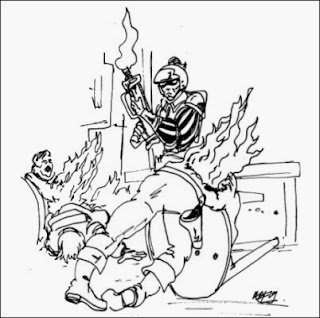(80's joke in the title...)
So it came as a bit of a shock to get to work on the 8th of November 1983,
and find Bob in a terrible mood, Kate warned us (Mark and I), just to stay out
of his way when he was in a foul mood, so we kept our heads down and got on
with whatever we had to do...
Shame really coz I'd had a terrific weekend, for the first time I'd travelled
away to help out at a wargames show... and not just any wargames show, oh no...
this was the BIG one.
Northern Militaire was held on the 5th and 6th of November in Oldham, at the Queen Elizebeth Hall. Bob had travelled
up on the Friday evening but I went on the Saturday morning with Rees (if
memory serves we went up in an escort-type hire-van rented from the place where
his wife worked... it's was foggy on the M1 and I remember Siouxsie
and the Banshees version of Dear Prudence on the radio...)
 |
| Queen Elizabeth Hall, Oldham |
TTG had a huge stand at the event by Bob's standards, which is why Rees and
I travelled up, and Bob roped in the willing hands of Bruce Rea-Taylor to make
four of us to cover the 24 feet.
My section of the stand was made up of the extra stock that Bob had arranged
to bring from Citadel.
That same weekend was Games Day in London,
and of course Citadel/GW were directing all their efforts toward that.
A deal was struck to exchange stock between Citadel and Bob, so that we
could both have a presence in, and a profit from, both events.
Rik Priestley and Richard Halliwell had come to the shop in Daybrook square
to bring stock for us to take to Oldham, and also to take away TTG rules and
minis for sale in London.
Northern Mil. was amazing for a young'un like me, it was so BIG, a couple or
three floors and although there were only a few games on, it was primarily a modelling
event, there was a much greater variety in displays, traders and public than a
normal wargames event...
And boy were we busy... now in my time I've stood trade shows like Salute or
Games Day where the public have been three or four deep at the stand, but
nothing came close to the two days of Northern Mil.
"Used to be better in the old place..." grumbled my Boss,
"... Never recovered from the change of venue..." But if shows did
get bigger and better than this, I would have been amazed.
 |
| Games Day '83, note the date. |
I remember being driven through Oldham in
the dark, heading for the hotel, and the road ran through all the old back to
back houses, which were lit with fires and fireworks... Punch drunk and tired I
sat drinking cola listening to the old Chaps joke in the bar... perfect.
Sunday, more of the same... Non stop customers... and non stop music too...
They used to play Top 20 War Film Themes over and over, all day long on the public
address system... Even Bob who liked a movie film theme, would be tiring for 636 Squadron by 11am on Sunday morning...
I bought some minis, a second hand Japanese Samurai army from the Bring& Buy. (more stuff for Tercio)
No club on Monday, a night off after a two day event, and then into work
again on Tuesday as normal.
Or not...
It transpired that Bob was fuming because all the stock, minis, rules,
displays, that we had sent to Citadel had not been taken to Games Day, they had
been left behind and TTG would get no presence, or profit, from the event
despite having to work double-hard to do two major events in one weekend, and
working hard and taking extra staff/space to sell the Citadel stuff at Northern
Mil.
I don't know if Bob even spoke to Bryan
on the normal Monday 'Run' or not, but as far as Bob was concerned, that was
it, The End.
Over that week, Bob had me take down all the Citadel miniatures stock from
the rack in the shop, other things would take its place, and we would have
no more contact with Citadel.
So, people often say to me, "oh the golden age of Game Workshop was such and such...
85-87, or 88-91, or mid 90's". Well for me the golden age of Citadel miniatures ran from the time that they
started on the Fantasy Tribes (81?), until the 8th of November 1983, the day that I found out that you
couldn't trust them, and they were only looking out for No.1.
And what next dear reader?
Why I suppose we need to judge Citadel's actions in context, so next time,
I'll muse on the changes in Citadel in the years of 82 and 83...
































